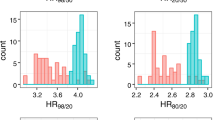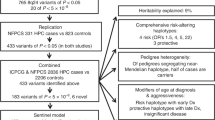Abstract
We followed our initial genome-wide association study (GWAS) of 527,869 SNPs on 1,172 individuals with prostate cancer and 1,157 controls of European origin—nested in the Prostate, Lung, Colorectal, and Ovarian (PLCO) Cancer Screening Trial prospective study—by testing 26,958 SNPs in four independent studies (total of 3,941 cases and 3,964 controls). In the combined joint analysis, we confirmed three previously reported loci (two independent SNPs at 8q24 and one in HNF1B (formerly known as TCF2 on 17q); P < 10−10). In addition, loci on chromosomes 7, 10 (two loci) and 11 were highly significant (between P < 7.31 × 10−13 and P < 2.14 × 10−6). Loci on chromosome 10 include MSMB, which encodes β-microseminoprotein, a primary constituent of semen and a proposed prostate cancer biomarker, and CTBP2, a gene with antiapoptotic activity; the locus on chromosome 7 is at JAZF1, a transcriptional repressor that is fused by chromosome translocation to SUZ12 in endometrial cancer. Of the nine loci that showed highly suggestive associations (P < 2.5 × 10−5), four best fit a recessive model and included candidate susceptibility genes: CPNE3, IL16 and CDH13. Our findings point to multiple loci with moderate effects associated with susceptibility to prostate cancer that, taken together, in the future may predict high risk in select individuals.
This is a preview of subscription content, access via your institution
Access options
Subscribe to this journal
Receive 12 print issues and online access
$209.00 per year
only $17.42 per issue
Buy this article
- Purchase on Springer Link
- Instant access to full article PDF
Prices may be subject to local taxes which are calculated during checkout



Similar content being viewed by others
References
Crawford, E.D. Epidemiology of prostate cancer. Urology 62, 3–12 (2003).
Steinberg, G.D., Carter, B.S., Beaty, T.H., Childs, B. & Walsh, P.C. Family history and the risk of prostate cancer. Prostate 17, 337–347 (1990).
Amundadottir, L.T. et al. A common variant associated with prostate cancer in European and African populations. Nat. Genet. 38, 652–658 (2006).
Freedman, M.L. et al. Admixture mapping identifies 8q24 as a prostate cancer risk locus in African-American men. Proc. Natl. Acad. Sci. USA 103, 14068–14073 (2006).
Gudmundsson, J. et al. Genome-wide association study identifies a second prostate cancer susceptibility variant at 8q24. Nat. Genet. 39, 631–637 (2007).
Haiman, C.A. et al. Multiple regions within 8q24 independently affect risk for prostate cancer. Nat. Genet. 39, 638–644 (2007).
Yeager, M. et al. Genome-wide association study of prostate cancer identifies a second risk locus at 8q24. Nat. Genet. 39, 645–649 (2007).
Gudmundsson, J. et al. Two variants on chromosome 17 confer prostate cancer risk, and the one in TCF2 protects against type 2 diabetes. Nat. Genet. 39, 977–983 (2007).
Schaid, D.J. The complex genetic epidemiology of prostate cancer. Hum. Mol. Genet. 13 Spec No 1, R103–21 (2004).
Skol, A.D., Scott, L.J., Abecasis, G.R. & Boehnke, M. Joint analysis is more efficient than replication-based analysis for two-stage genome-wide association studies. Nat. Genet. 38, 209–213 (2006).
Frazer, K.A. et al. A second generation human haplotype map of over 3.1 million SNPs. Nature 449, 851–861 (2007).
Prorok, P.C. et al. Design of the Prostate, Lung, Colorectal and Ovarian (PLCO) Cancer Screening Trial. Control. Clin. Trials 21, 273S–309S (2000).
Gohagan, J.K., Prorok, P.C., Hayes, R.B. & Kramer, B.S. The Prostate, Lung, Colorectal and Ovarian (PLCO) Cancer Screening Trial of the National Cancer Institute: history, organization, and status. Control. Clin. Trials 21, 251S–272S (2000).
Calle, E.E. et al. The American Cancer Society Cancer Prevention Study II Nutrition Cohort: rationale, study design, and baseline characteristics. Cancer 94, 2490–2501 (2002).
Chen, Y.C. et al. Sequence variants of Toll-like receptor 4 and susceptibility to prostate cancer. Cancer Res. 65, 11771–11778 (2005).
Valeri, A. et al. Segregation analysis of prostate cancer in France: evidence for autosomal dominant inheritance and residual brother-brother dependence. Ann. Hum. Genet. 67, 125–137 (2003).
The ATBC Cancer Prevention Study Group. The alpha-tocopherol, beta-carotene lung cancer prevention study: design, methods, participant characteristics, and compliance. Ann. Epidemiol. 4, 1–10 (1994).
Chanock, S.J. et al. Replicating genotype-phenotype associations. Nature 447, 655–660 (2007).
Zanke, B.W. et al. Genome-wide association scan identifies a colorectal cancer susceptibility locus on chromosome 8q24. Nat. Genet. 39, 989–994 (2007).
Easton, D.F. et al. Genome-wide association study identifies novel breast cancer susceptibility loci. Nature 447, 1087–1093 (2007).
Janssen, J.W. et al. Concurrent activation of a novel putative transforming gene, myeov, and cyclin D1 in a subset of multiple myeloma cell lines with t(11;14)(q13;q32). Blood 95, 2691–2698 (2000).
Buckland, P.R. et al. Strong bias in the location of functional promoter polymorphisms. Hum. Mutat. 26, 214–223 (2005).
Nam, R.K. et al. A novel serum marker, total prostate secretory protein of 94 aminoacids, improves prostate cancer detection and helps identify high grade cancers at diagnosis. J. Urol. 175, 1291–1297 (2006).
Reeves, J.R., Dulude, H., Panchal, C., Daigneault, L. & Ramnani, D.M. Prognostic value of prostate secretory protein of 94 amino acids and its binding protein after radical prostatectomy. Clin. Cancer Res. 12, 6018–6022 (2006).
Beke, L., Nuytten, M., Van Eynde, A., Beullens, M. & Bollen, M. The gene encoding the prostatic tumor suppressor PSP94 is a target for repression by the Polycomb group protein EZH2. Oncogene 26, 4590–4595 (2007).
Paliwal, S. et al. The alternative reading frame tumor suppressor antagonizes hypoxia-induced cancer cell migration via interaction with the COOH-terminal binding protein corepressor. Cancer Res. 67, 9322–9329 (2007).
Koontz, J.I. et al. Frequent fusion of the JAZF1 and JJAZ1 genes in endometrial stromal tumors. Proc. Natl. Acad. Sci. USA 98, 6348–6353 (2001).
Dixon, A.L. et al. A genome-wide association study of global gene expression. Nat. Genet. 39, 1202–1207 (2007).
Wang, X.D. et al. Expression profiling of the mouse prostate after castration and hormone replacement: implication of H-cadherin in prostate tumorigenesis. Differentiation 75, 219–234 (2007).
Gimm, O. et al. Somatic mutation and germline variants of MINPP1, a phosphatase gene located in proximity to PTEN on 10q23.3, in follicular thyroid carcinomas. J. Clin. Endocrinol. Metab. 86, 1801–1805 (2001).
Acknowledgements
The Prostate Lung Colorectal Ovarian Cancer Screening Trial (PLCO) was supported by the Intramural Research Program of the Division of Cancer Epidemiology and Genetics and by contracts from the Division of Cancer Prevention, National Cancer Institute, US National Institutes of Health, Department of Health and Human Services. The Health Professionals Follow-up Study (HPFS) study is supported by the US National Institutes of Health grant CA55075 and U01CA098233. The American Cancer Society (ACS) study is supported by U01 CA098710. The Alpha Tocopherol Beta-Carotene Cancer Prevention study (ATBC) Study is supported by the Intramural Research Program of the National Cancer Institute, NIH, and by US Public Health Service contracts N01-CN-45165, N01-RC-45035, and N01-RC-37004 from the National Cancer Institute, Department of Health and Human Services. F.R.S. is supported by a NRSA training-grant (T32 CA 09001). Centre de Recherche pour les Pathologies Prostatiques (CeRePP) thanks J.P.B. and Generali for their charitable donations which have contributed to this project. This project has been funded in whole or in part with federal funds from the National Cancer Institute, National Institutes of Health, under contract N01-CO-12400. The content of this publication does not necessarily reflect the views or policies of the Department of Health and Human Services, nor does mention of trade names, commercial products, or organizations imply endorsement by the US Government.
Author information
Authors and Affiliations
Corresponding author
Supplementary information
Supplementary Text and Figures
Supplementary Methods, Supplementary Tables 1–9, Supplementary Figures 1 and 2 (PDF 1670 kb)
Rights and permissions
About this article
Cite this article
Thomas, G., Jacobs, K., Yeager, M. et al. Multiple loci identified in a genome-wide association study of prostate cancer. Nat Genet 40, 310–315 (2008). https://doi.org/10.1038/ng.91
Received:
Accepted:
Published:
Issue Date:
DOI: https://doi.org/10.1038/ng.91
This article is cited by
-
Extensive germline-somatic interplay contributes to prostate cancer progression through HNF1B co-option of TMPRSS2-ERG
Nature Communications (2022)
-
Analyzing Multiple Phenotypes Based on Principal Component Analysis
Acta Mathematicae Applicatae Sinica, English Series (2022)
-
HNF1β is a sensitive and specific novel marker for yolk sac tumor: a tissue microarray analysis of 601 testicular germ cell tumors
Modern Pathology (2020)
-
Expanding cancer predisposition genes with ultra-rare cancer-exclusive human variations
Scientific Reports (2020)
-
Prostate cancer risk prediction using a polygenic risk score
Scientific Reports (2020)



